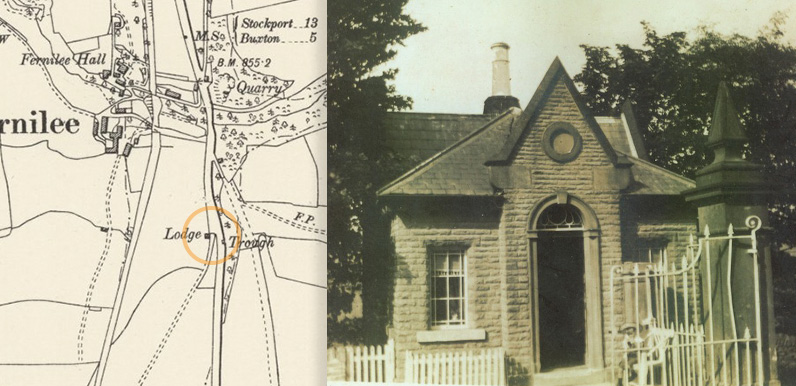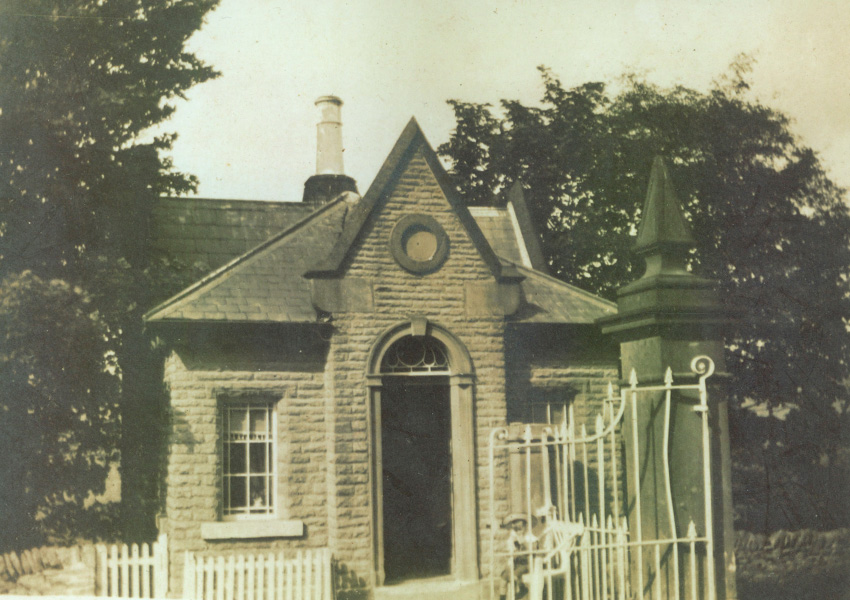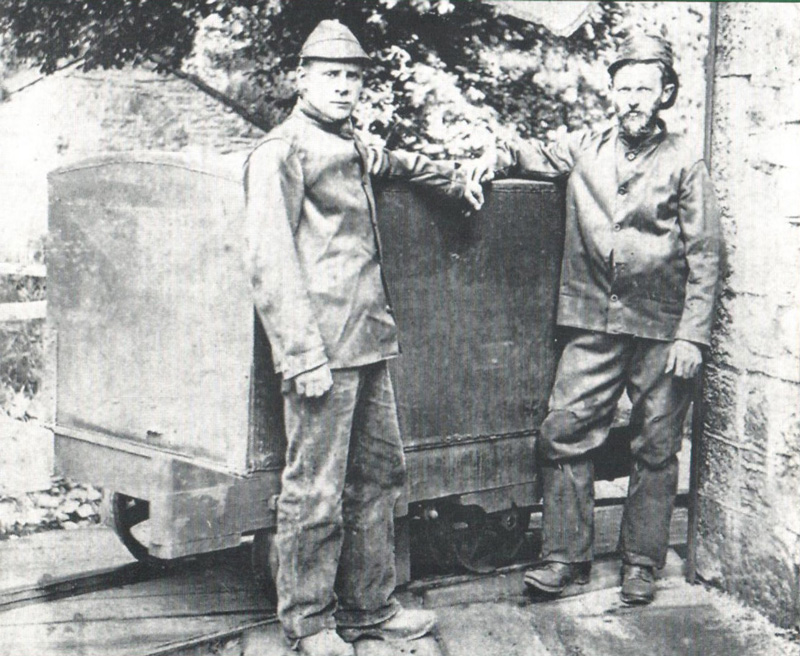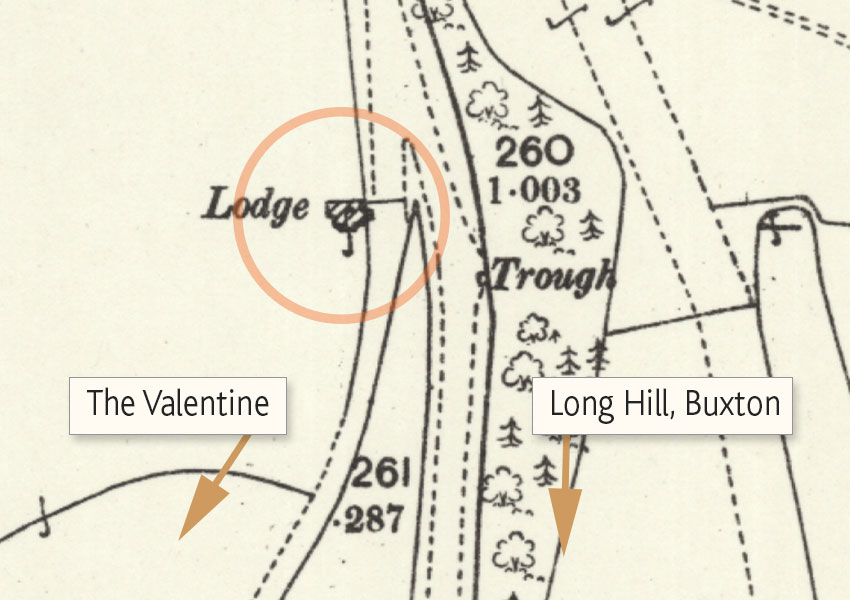Gerald Hancock, author of ‘Goyt Valley Romance’ – and sadly no longer with us – kindly allowed me to scan his collection of Goyt Valley photos when I first started this website back in 2010.
The photos were very much the inspiration for my research into the history of the valley. I’ve always enjoyed trying to trace the various buildings and people captured in the images.
One photo has always particularly intrigued me. Gerald captioned it ‘The Bottom Lodge; Mrs Pickup kept a shop here’. But I’ve never managed to find where it was located.
I’ve just finished creating a number of ‘then & now’ fades of the Goyt, all the way from Goyt’s Moss in the south to Taxal in the north (click to view). And I noticed a building marked ‘Lodge’ close to the village of Fernilee.
Then & now fade
I’ve created this fade between the 1888 map with today’s satellite view of the same area today.
The building lay at the end of the lane leading from the gunpowder mill up to the Long Hill road between Buxton and Whaley Bridge. The factory is just out of the frame at bottom left. The northern edge of Fernilee Reservoir is visible at the bottom of the satellite view.
(For anyone interested in the route of the Cromford & High Peak Railway line, fading between the views highlights the track as it heads north to Whaley Bridge.)
Today the lane is used to access the car park at the northern end of Fernilee Reservoir. But I don’t think there’s any building at the top today. I no longer live close to the valley, so can’t easily check. But I’d be grateful for any help from anyone who could take a look. (Simply leave a comment below.)
I may be completely wrong about the building. It could be situated somewhere else entirely. But I believe the Grimshawe family used this lane as their main route coming and going from their Errwood Estate. And it does look like a typical Victorian-style gatehouse.
So my guess is that it could fit the bill. But I said the same about the shrine on Goyt’s Lane. And I was completely wrong about that! If anyone knows about the building, please leave a comment below. Or send me a message.
Above: This photo shows William Simpson on the left alongside a co-worker at the gunpowder mills (click to enlarge).
It features on the cover of Joyce’s wonderful history of the factory, the ruins of which now lie beneath the northern end of Fernilee Reservoir.
Page update #1
I’ve just finished reading Joyce Winfield’s ‘The Gunpowder Mills of Fernilee‘ and a mention of a ‘top lodge’ caught me eye. Gerald captioned the photo ‘bottom lodge’. But Joyce thinks it may be the same building (see comment below). Here’s the excerpt from her book;
William Simpson, cousin of the Rev. Willie Simpson of Chinley Independent Chapel, came to the valley to work at the Powder Mills when he married Letitia Lomas. Their first proper home was Top Lodge, that tiny gatehouse built of dressed stone which used to guard the entrance to the Errwood estate, and there they stayed until 1937.
Life wasn’t easy bringing up three children without water, gas or electricity. Water had to be carried from the well across the road down through a trap door to the cellar-kitchen and clean washing carried back the same way to the line near the well. Fruit and vegetables – for which William won prizes – were grown on a piece of ground at the back until the Water Board took it from them.
Letitia Simpson had it hard from the beginning. Her father, John Lomas, had been a blacksmith in Sheen. When he died of a heart attack at 39, his wife, Rachel, pregnant with their fifth child, took the children and set off at 4.30 in the morning to find work at Burbage Laundry.
By washing blankets with a dolly tub, and peg working in the fields, Letitia supplemented Rachel’s income to a small degree. Enough only for food, so when the rent went unpaid the bailiffs took all but the table and chairs and the mattresses.
No bitterness followed these early hardships. No matter how little there was in the pantry, there was always a place at the table for a visitor, and a chalk cross on the well was the tramps’ sign that a meal would always be provided.
Page update #2
I’ve found a more detailed map from the 1890s which better shows the shape of the lodge. And it looks very much like the same shape, confirming the photo is this building (click to enlarge).
Page update #3
I’ve now added Upper Lodge to the page listing all the farmhouses demolished following Stockport Corporation’s purchase of the Errwood Estate in 1930 to build the twin reservoirs. Click to view.





Today – or last week to be accurate – there’s no building at the point where your lodge appears on the map.
I’ve found an Alfred (b.1861) and Mary (b.1864) Pickup in the 1891 census, living in Haybottom, Taxal. He is listed as a general labourer and she a cotton winder. In both the 1901 and 1911 censuses they were living on Buxton Road, Whaley Bridge.
Albert and Mary had 4 (found) children, James, Florence, Hilda and Nellie. James married Lena (Hutchinson) and lived in Yorkshire in 1911 census. Mary Pickup may well be the shopkeeper mentioned in Gerald’s caption.
If you follow this link on the Furness Vale Local History website and scroll down to the “School Group” photograph there is mention of The Lodge. A school photo of the early 1890s shows Thomas Wilson who was born at The Lodge, Fernilee in 1881.
This interests me: Mrs Mary Pickup was born Mary Bates, and was my great-aunt, although I never knew her. Her sister Sarah Ellen Bates married my Grandfather Alfred Hulme, but they died before I was born. Among some family relics I have a picture of the old Horwich End Post Office, which was run by their brother Eli Bates, and on the back is written ‘E Bates 1928 / from Bottom Lodge, Goyt Valley / Moved to Start Lane?’. Not that it helps identify the building, but it might help someone.
I think this is the gatehouse at the top of the Valentine, which is what we call the road leading down to Fernilee Reservoir, and what used to be the drive to Errwood Hall via the gunpowder mill. It was demolished before I was born, maybe in the thirties when the reservoir was built.
William Simpson lived there with his family. It was a pretty house; tiny and on three levels his daughter, Mary, told me, and the trough across the road on the map was called Simpson’s Well, which is where they got their water.
In this Derbyshire Heritage web page there is the following entry: “When the water level of Errwood Reservoir drops significantly you can see the remains of the lower part of the Driveway to the Hall, the Lodge, Cottages, Farms and the Old Packhorse Bridge which were at the heart of this community, the last time these were visible was 1991.”
I remember in the late 1980s parking on the main road at the top of the lane down to the Fernilee Reservior becuase of heavy snow. I noticed a strange wall below the parapet wall at the top. I wondered about it at the time but thought maybe it was an electricity substation or something. It would have been in the right place.
Yes it is Top Lodge. The bottom story of the building is still there but it’s below the road level in the trees. If I remember there is a blocked up doorway and a window.
As a child I sheltered in the doorway of the top lodge while waiting for the school bus. We lived at Oldfield Farm, the roof was still on then, that was in the early 1950s. Anney Wild was the bus conductor, she lived in the cottages across the road.
Many thanks to Mike for giving the link to my comment about Thomas Wilson, which alerted me to to this treasure trove of a site so that I can make this belated contribution. Thomas Ernest Wilson was my grandfather and his 1881 birth certificate just says he was born in the Lodge, Fernilee, but it was definitely the Top Lodge. I thought a summary of the census returns 1851-1911 would give a snapshot of the close-knit families of the valley during that time. It also shows the sheer number of people who lived in the Lodges in the nineteenth century. According to the census returns Top Lodge had four rooms and Bottom Lodge two. (The names change but I always give the Top Lodge first.)
1851: 2 the Lodge: William Wilson (my great-great grandfather) & family (7). 1 the Lodge: Jodrell (3)
1861: Higher Lodge: William Wilson & family (10). Lower Lodge: Jodrell (2)
1871: Higher Lodge: Jodrell (11). Lower Lodge: Jodrell (2)
1881: Top Lodge: James Wilson (my great-grandfather) & family (10). Lower Lodge: Jodrell (2)
1891: Top Lodge: Dranfield (3). Bottom Lodge (Powder Mill Road, Railway Crossing): Matthew Wilson (my great-uncle) & family (6)
1901: Top Lodge: Lowe (5). Bottom Lodge: Lomas (2)
1911: Top Lodge: Simpson (4). Bottom Lodge: Lomas (3)
I recently found out that my wife’s 3 x grandparents James and Ann Mitchell lived in Top Lodge, Fernilee in 1864. This information was on Ann’s death certificate which showed Top Lodge as her residence and place of death.
Interestingly, in the 1861 census three years earlier, they were living in one of the Fernilee Cottages which are next to Folds End Farm. The cottages are still there today.
It did seem from one of the previous comments on here that families moved around quite a bit so maybe this was the case!
They did indeed move around: William Wilson and his family, who were living in the Top Lodge in 1861, by 1871 had moved to the family farm, Stubbin(g)s. They must have moved before 1864.